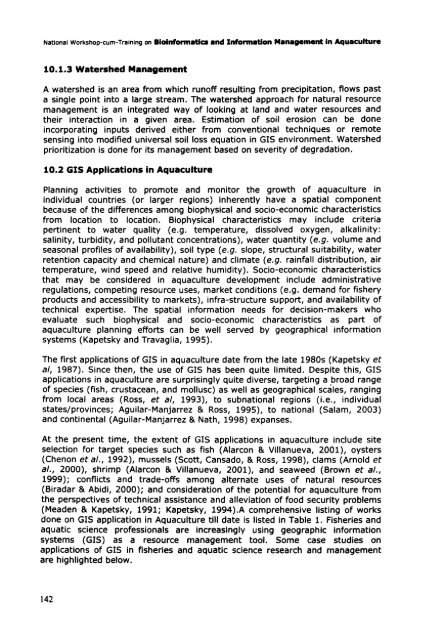4 - Central Institute of Brackishwater Aquaculture
4 - Central Institute of Brackishwater Aquaculture
4 - Central Institute of Brackishwater Aquaculture
You also want an ePaper? Increase the reach of your titles
YUMPU automatically turns print PDFs into web optimized ePapers that Google loves.
National Workshop-cum-Training an Bioinfwmaticr and Intonnation Manapemant in <strong>Aquaculture</strong><br />
10.1.3 Watershed Management<br />
A watershed is an area from which run<strong>of</strong>f resulting from precipitation, flows past<br />
a single point into a large stream. The watershed approach for natural resource<br />
management is an integrated way <strong>of</strong> looking at land and water resources and<br />
their interaction in a given area. Estimation <strong>of</strong> soil erosion can be done<br />
incorporating inputs derived either from conventional techniques or remote<br />
sensing into modified universal soil loss equation in CIS environment. Watershed<br />
prioritization is done for its management based on severity <strong>of</strong> degradation.<br />
10.2 GIs Applications in <strong>Aquaculture</strong><br />
Planning activities to promote and monitor the growth <strong>of</strong> aquaculture in<br />
individual countries (or larger regions) inherently have a spatial component<br />
because <strong>of</strong> the differences among biophysical and socio-economic characteristics<br />
from location to location. Biophysical characteristics may include criteria<br />
pertinent to water quality (e.g. temperature, dissolved oxygen, alkalinity:<br />
salinity, turbidity, and pollutant concentrations), water quantity (e.g. volume and<br />
seasonal pr<strong>of</strong>iles <strong>of</strong> availability), soil type (e.g. slope, structural suitability, water<br />
retention capacity and chemical nature) and climate (e.g. rainfall distribution, air<br />
temperature, wind speed and relative humidity). Socio-economic characteristics<br />
that may be considered in aquaculture development include administrative<br />
regulations, competing resource uses, market conditions (e.g, demand for fishery<br />
products and accessibility to markets), infra-structure support, and availability <strong>of</strong><br />
technical expertise. The spatial information needs for decision-makers who<br />
evaluate such biophysical and socio-economic characteristics as part <strong>of</strong><br />
aquaculture planning efforts can be well served by geographical information<br />
systems (Kapetsky and Travaglia, 1995).<br />
The first applications <strong>of</strong> GIS in aquaculture date from the late 1980s (Kapetsky et<br />
al, 1987). Since then, the use <strong>of</strong> GIs has been quite limited. Despite this, GIs<br />
applications in aquaculture are surprisingly quite diverse, targeting a broad range<br />
<strong>of</strong> species (fish, crustacean, and mollusc) as well as geographical scales, ranging<br />
from local areas (Ross, et a/, 1993), to subnational regions (i.e., individual<br />
states/provinces; Aguilar-Manjarrez & Ross, 1995), to national (Salam, 2003)<br />
and continental (Aguilar-Manjarrez & Nath, 1998) expanses.<br />
At the present time, the extent <strong>of</strong> GIs applications in aquaculture include site<br />
selection for target species such as fish (Alarcon & Villanueva, 2001), oysters<br />
(Chenon etal., 1992), mussels (Scott, Cansado, & Ross, 1998), clams (Arnold et<br />
a/., 2000), shrimp (Alarcon & Villanueva, 2001), and seaweed (Brown et a/.,<br />
1999); conflicts and trade-<strong>of</strong>fs among alternate uses <strong>of</strong> natural resources<br />
(Biradar & Abidi, 2000); and consideration <strong>of</strong> the potential for aquaculture from<br />
the perspectives <strong>of</strong> technical assistance and alleviation <strong>of</strong> food security problems<br />
(Meaden & Kapetsky, 1991; Kapetsky, 1994).A comprehensive listing <strong>of</strong> works<br />
done on GIs application in <strong>Aquaculture</strong> till date is listed in Table 1. Fisheries and<br />
aquatic science pr<strong>of</strong>essionals are increasingly using geographic information<br />
systems (GIS) as a resource management tool. Some case studies on<br />
applications <strong>of</strong> GIS in fisheries and aquatic science research and management<br />
are highlighted below.

















